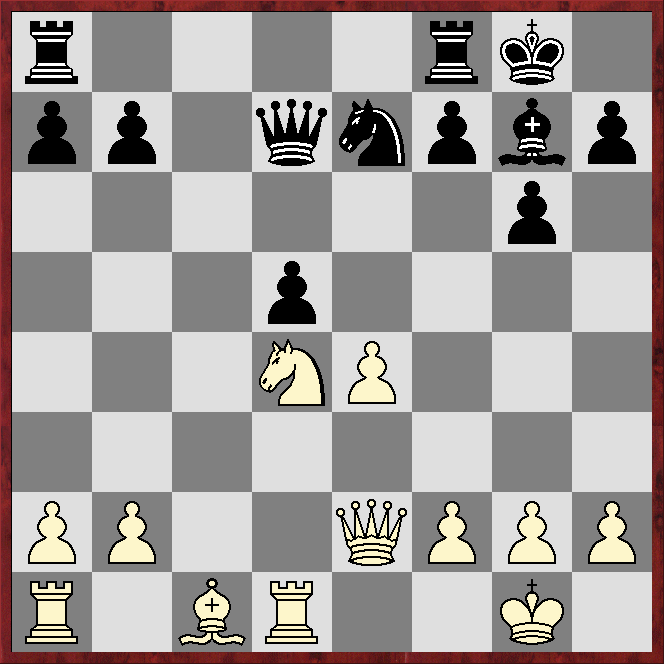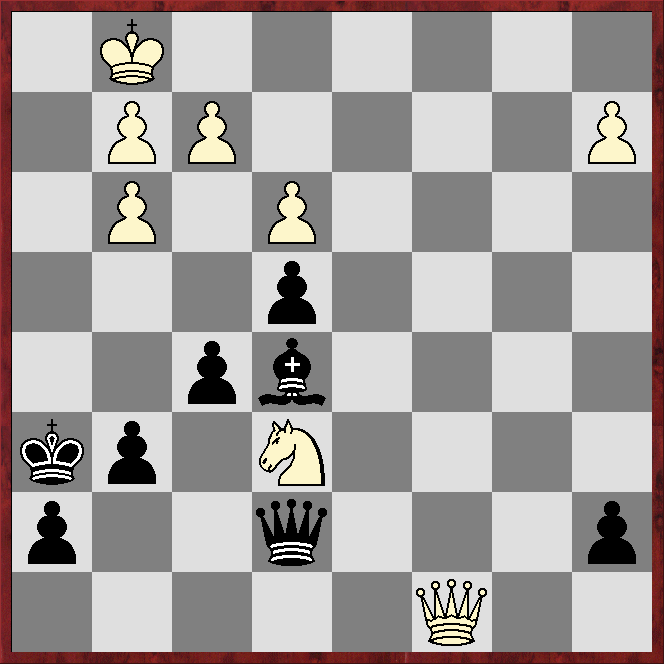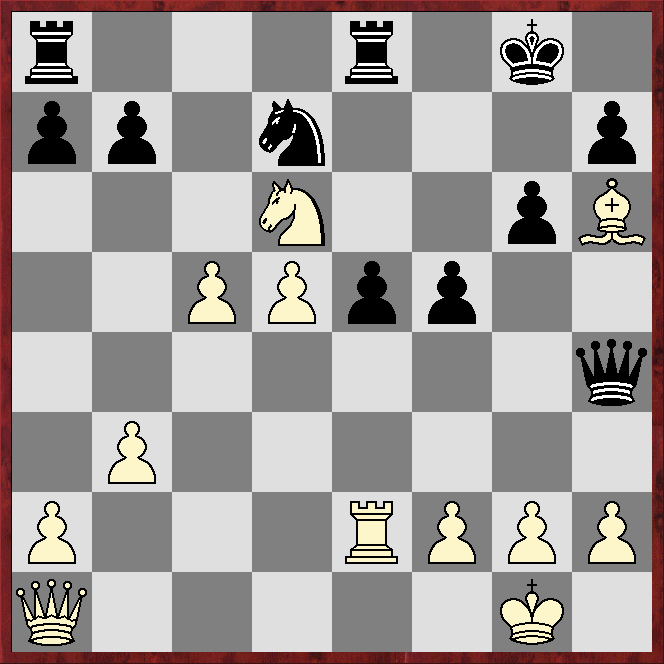Hartmut Moritz (2066) - Spanton (1895)Ponziani
1.e4 e5 2.Nf3 Nc6 3.c3 Nf6!?
This is easily the most popular move in ChessBase's 2023 Mega database, although it scores eight percentage points lower than 3...d5.
4.d4 Nxe4!?
Magnus Carlsen preferred the more common 4...exd4 in a 2013 win over Yifan Hou at Tata Steel (Wijk aan Zee, Netherlands).
5.Bd3!?
The mainline in Mega23 runs 5.d5 Ne7 6.Nxe5 Ng6 7.Nxg6 hxg6 8.Bd3 Nf6 9.0-0 with maybe a slight edge for White, according to Stockfish15 and Komodo13.02.
5...d5 6.Nxe5
The engines slightly prefer this over 6.dxe5 Bg4.
6...Nxe5 7.dxe5 Nc5?!
The knight was well-placed on e4. The c5 square is not bad either, but Black is spending a tempo driving the white light-square bishop to arguably a better square. The engines suggest 7...Bc5, claiming equality, one point being 8.Bxe4 can be met by 8...Qh4. Instead White should probably castle.
8.Bc2 Be7 9.0-0 0-0 10.Qh5!?
This may be a novelty. A known continuation is 10.b4 Ne4 11.f3, when White was at least slightly better, according to the engines, in Andrew Morley (2065) - Renāte Vidruska (2045), 4NCL Team Championship Online 2020, although Black won in 46 moves.
10...g6 11.Qe2 f6 12.Bh6 Rf7!? 13.b4?!
The engines strongly dislike this, claiming it leaves Black better. They suggest 13.exf6 Bxf6 and either 14.Nd2 or 14.Re1, when Stockfish15 gives White a slight edge but Komodo13.02 calls the position equal.
13...Ne6 14.f4
The engines prefer 14.Nd2 or 14.exf6, but give Black at least the upper hand.
 |
| How should Black respond? |
*****
*****
*****
*****
*****
14...fxe5
This seems best, although the engines also like 14...a5!? But forcing an exchange of dark-square bishops with 14...Bf8?! throws away most of Black's advantage, according to the engines, while they reckon the passive 14...Nf8? gives White at least the upper hand after 15.Nd2.
15.f5!?
This is White's idea, whereas recapturing with 15.fxe5?! lets Black swop a pair of rooks and so relieve the pressure.
 |
| What should Black play? |
*****
*****
*****
*****
*****
15...gxf5!
This is clearly best, according to the engines. If 15...Nf4 then 16.Bxf4 exf4 17.fxg6 hxg6 18.Bxg6 Rg7 is much better for Black, despite the exposed black king, according to the engines. However they reckon sacrificing the exchange with 16.Rxf4! exf4 17.fxg6 hxg6 18.Bxg6 is much less clear, eg 18...Rf6? 19.Qh5 wins for White. Instead Black should probably play 18...Qd6!? 19.Bxf7+ Kxf7 20.Qh5+ Qg6 21.Qxg6+ Kxg6, when 22.Bxf4 leaves White a pawn up but Black gets strong play with the bishop-pair, eg 22...Bf6 23.Kf2 (23.Bxc7? Bf5) Be6 24.Be3 a5 25.bxa5 Rxa5, although the line is not very forcing and White remains with an extra pawn.
16.Qxe5?
Better is 16.Bxf5, when 16...Nf4!? 17.Bxf4 exf4 (capturing the light-square bishop lets White equalise with 18.Bxe5, according to the engines) 18.Bxc8 leaves White a pawn down, whichever way Black recaptures, but Black has pawn weaknesses and an exposed king.
16...Bd6 17.Qe1
This seems best. Certainly not 17.Qxd5?? Bxh2+ etc.
17...Qf6
Even stronger, according to the engines, is 17...f4.
18.Be3 Qe5 19.Qg3+
This seems necessary as 19.g3? f4 is much worse for White, according to the engines.
19...Qxg3 20.hxg3 Bxg3!? 21.Bxf5 Nf8?!
Not 21...Ng7? 22.Bxh7+!, but the engines' 21...Be5 and 21...Nd4!? are probably better.
22.Bc2?
Exchanging on c8, or dropping the bishop to d3 from where it covers the king's rook, is better.
22...Rxf1+?
This is winning but much better is 23.Bxh2+!
23.Kxf1 Bd7?!
Hoping to play 24...Bb5+, but that is little more than a check. Best seems to be 23...Be5, one point being 24.Bd4?! runs into 24...Bxd4 25.cxd4 Ne6.
24.Na3?!
Preventing 24...Bb5+, but the knight has few prospects on a3. The engines give 24.Bb3 c6 (24...Bb5+ 25.Kg1 is not a problem for White) 25.Nd2, albeit with the upper hand for Black.
24...Ng6 25.Rd1 Re8 26.Bc5?!
Objectively better is 26.Bf2 Rf8 27.Rd2, but Black can simplify at will.
26...Bg4 27.Rc1 Nf4 28.Bb3 b6 29.Bf2
There seems nothing better, but White is completely lost.
29...Bxf2 30.Kxf2 Nd3+ 31.Kg3 Nxc1 32.Kxg4 Nxb3 33.axb3 c6 (0-1, 50 moves)















































